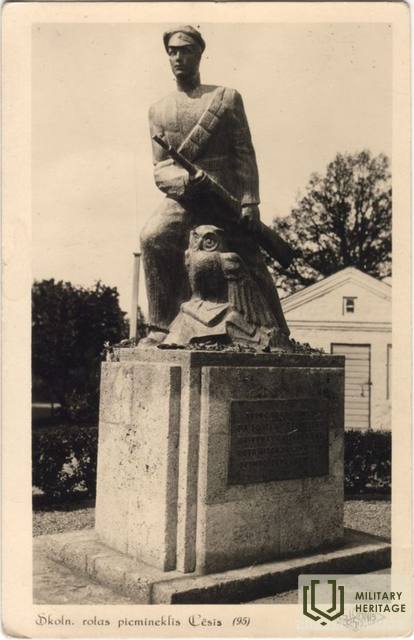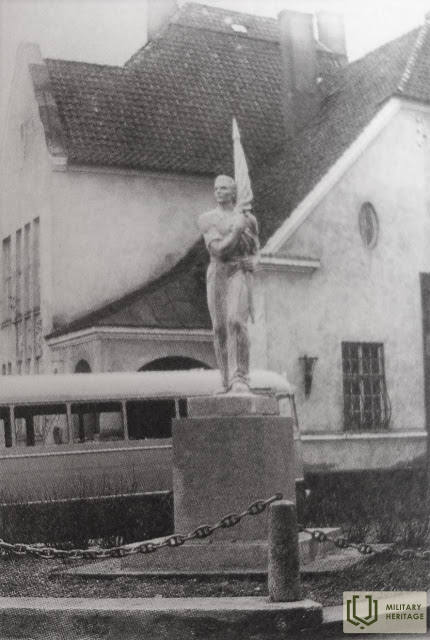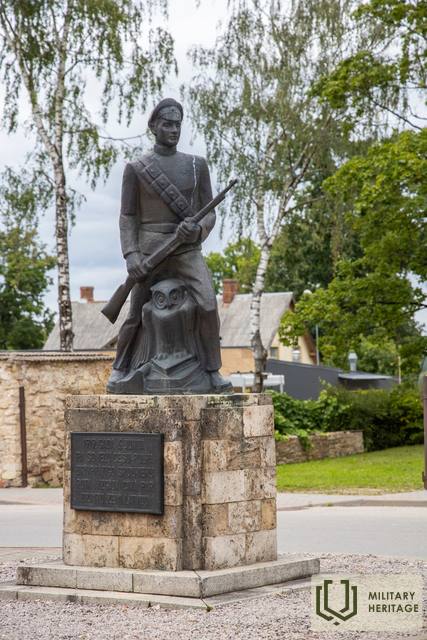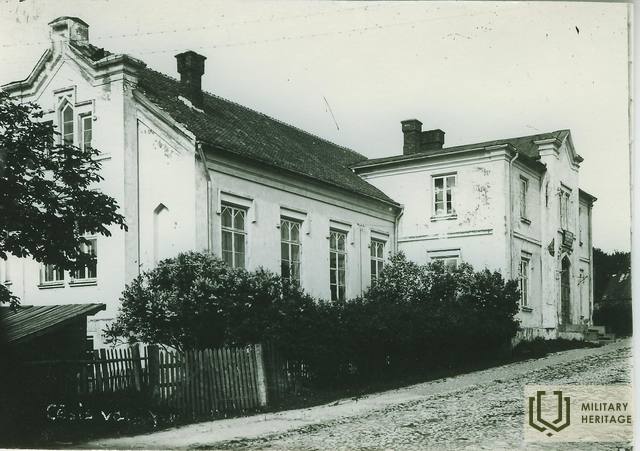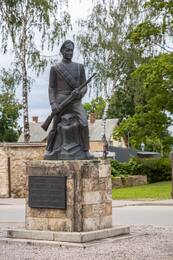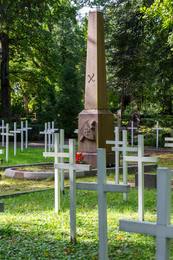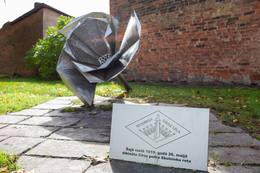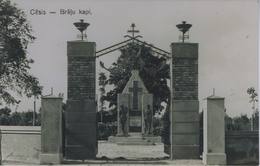Neįprasta paminklo Cėsių pulko mokyklinei kuopai istorija
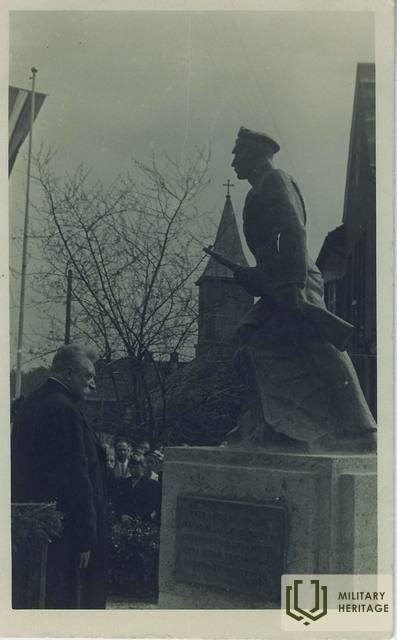
1919 m. Cėsių mūšiuose dalyvavo Cėsių pulko savanorių mokinių kuopa, kuri birželio 5 d. buvusios Cėsių vokiečių progimnazijos patalpose Dārza gatvėje (dabar Bērzaines g. 4) susibūrė kaip kovinis būrys iš 108 Valmieros ir Cėsių mokyklų jaunuolių. Jau naktį iš birželio 5 d. į 6 d., maždaug valandą po vidurnakčio, nuskambėjo aliarmas ir įmonei buvo liepta persikelti į vietą. Kuopa žengė į Mācītājmuiža – Meijermuiža liniją, kuri buvo laikoma svarbiausia mūšio zona.
Kai tik buvo gauta žinia apie karo veiksmų pradžią, mūšio štabas arba „pulko operatyvinis štabas tuoj pat pajudėjo arčiau fronto“ į Heermeisteros gatvę Nr. 16 (dabar Gaujos g. Nr. 16). gydytojo Wilhelmo Lenzo namas. Trečiojo dešimtmečio pradžioje šį pastatą įsigijo Cėsių amatininkų draugija, tačiau po II pasaulinio karo jame veikė laikraščio „Padomju Druva“ (nuo 1990 m. kovo mėn. laikraštis „Druva“) redakcija ir spaustuvė. Išvykdami į mūšio lauką Mokyklos kuopos kareiviai, atėję Palasta gatve iš vokiečių vidurinės mokyklos rikiuotės, pulko štabe gavo granatas. Netoli štabo Heermeisteros (Gaujas) gatvėje kuopos kariai taip pat buvo gavę trumpą karinį instruktažą. Savo ruožtu 2-ojo Cėsių pėstininkų pulko vado vado postas buvo kitoje gatvės pusėje – Heermeistera gatvėje Nr. 11 (dabar Gaujos g. Nr. 11). XIX amžiaus pabaigoje čia buvo iškilaus baltų vokiečių archeologo Georgo von Sieverso „Villa bei Wenden“.
Renginių dalyvis 10 -osiose „Cēsis“ mūšio metinėse laikraštyje „Pēdējā Brīdī“ (JA „Prieš 10 metų, Cēsis pulkas prieš„ Landeswehr “ Dārza gatve, padalyta į specialius vienetus, ir paskirstė gyvą amuniciją. Uiža, Juriģumuiža ir Mācītājmuiža užėmė centrinę Cēsis pulko kovos zoną ir saugojo Meijermuiža - Mācītājmuiža liniją, įjungimą “.
1938 m. gegužės 26 d., maždaug už 100 m nuo buvusios Cėsių vokiečių progimnazijos, Dārza ir Palasta (dabar Bērzaines ir Palasta) gatvių sankirtoje, buvo atidengtas paminklas, skirtas Moksleivių vakarėliui. Naktį iš 1919 m. birželio 5 d. į 6 d. į pirmąjį mūšį išėjo vidurinės mokyklos mokiniai, neišmokę karinio meno. Tai simbolizavo nerangiai sugriebtas studento šautuvas, išlietas iš bronzos. Kad mokyklinius reikmenis laikinai pakeitė ginklai, priminė ir pelėda bei knygos prie mokinio kojų. Paminklo projekto autorius buvo buvęs Mokinių kuopos karys, dailininkas Jānis Rozenbergs (1901-1966), tačiau idėją įgyvendino skulptorius Rūdolfas Ābol(t)iņš (1909-1944) ir metalkalvis Jānis Zibens (1909-1967).
1950 m. paminklas buvo demontuotas kaip nepageidaujamas sovietų režimui.
Prasidėjus Atbudimui, pirmoji paminklo atkūrimo idėją išsakė 1942 m. Cėsių valstybinės gimnazijos abiturientai, gyvenę tremtyje, 1989 m. lankydamiesi Latvijoje. Jie taip pat pradėjo rinkti tam reikalingas lėšas. Tačiau Cėsių miesto taryba sprendimą paminklą atkurti ir įrengti pirminėje vietoje priėmė tik 1992 metų rugsėjo 24 dieną atkūrus Latvijos nepriklausomybę.
Nors oficialus susitarimas atkurti paminklą buvo vos pasiektas, realiai jo darbai jau buvo pradėti. Rugsėjo 26 dieną rajono laikraštis „Druva“ pranešė, kad paminklo pagrindui paruoštas travertinas, o skulptorė Maija Baltiņa kartu su architektu Imantu Timermaniu pradėjo kurti bronzinę statulą.
Tačiau 1992 metų rugsėjo 30 dieną į Valstybinę kultūros paminklų apsaugos inspekciją (VKPAI) ir Mišių kapų komitetą (BKK) kreipėsi Atgimimo pradžioje paramos paminklo įrengimui ieškojęs cesiškis Ādolfas Cābulis, užmezgęs ryšius su tremtiniais. Jis tvirtino, kad dabar iniciatyvą atstatyti paminklą perėmė kiti asmenys, kurie veikia savanaudiškais tikslais ir nėra gavę reikiamo valdžios leidimo. Šios grupės atstovai, tarp kurių buvo skulptorius Andrejus Jansonas, paminklą planavo atidengti 1992 m. lapkričio 11 d., pastatydami jį maždaug 15 metrų nuo pradinės vietos. Paminklas taip pat planuota patirti didelių vizualinių pokyčių, nes J. Rozenbergo sukurtas karys šautuvą laikė kaire ranka, taip pabrėždamas paskubomis formuojamos Mokyklos kuopos karinį nepasirengimą, o M. Baltinės sukurtas jaunuolis – dešine ranka. Taip pat skyrėsi ir medžiaga – iš pradžių paminklas buvo pagamintas iš vario, o dabar išlietas iš bronzos. Buvusi bronzinė lenta buvo pakeista varine lenta.
Siekdama atlikti papildomus istorinius tyrimus, Cėsių miesto taryba 1992 metų spalio 4 dieną nusprendė sustabdyti paminklo restauravimą, tačiau paminklo kūrėjai į tai neatsižvelgė ir naujai pasirinktoje vietoje įrengė bazę su laipteliais. Poreikis ten pastatyti paminklą buvo paaiškintas komunistinės okupacijos metais įvestais transporto judėjimo Bērzaines gatve pokyčiais, kurių nebebuvo galima atsisakyti. Nors savivaldybė siūlė palaukti iki kitų metų bandant sukurti paminklo maketą gamtoje jo istorinėje vietoje, miesto tarybos veiksmus ribojo lėšų trūkumas. Už jau įrengtą bazę ir pagamintą bronzinę statulą buvo sumokėta lėšomis, surinktomis aukas iš Dauguvos vanagų Cėsių skyriaus, tremtinių latvių, Latvijos liaudies fronto. Todėl buvo priimtas sprendimas atkurtą paminklą atidengti 1992 metų lapkričio 11 dieną, įrengiant jį netoli istorinės vietos. 1992 metų lapkričio 11 dieną atidengtas skulptorės Maijos Baltinės (1941-2016) sukurtas paminklas.
Tuo pat metu, 1992 m., buvo demontuotas okupacinio režimo pastatytas skulptoriaus Kārlio Jansono paminklas „Komsomol vėliavnešys“.
Tālis Pumpuriņš, Cėsių istorijos ir meno muziejus
https://karavirukapi.blogspot.com/2020/02/cesis-piemineklis-cesu-pulka-skolnieku.html
http://sovietheritage.blogspot.com/2017/04/cesu-rajona-padomju-laika-zudusie.html
Susijusi laiko juosta
Susijusios temos
Susijusios vietos
Monument for students of the Cēsis Regiment
The monument to the soldiers of the Cēsis Regiment Students’ Company who died in the Battles of Cēsis is located in the city of Cēsis, near the intersection of Palasta and Bērzaines streets. The construction of the monument was proposed by the Soldiers’ Association of the Cēsis Regiment Students’ Company. The monument was unveiled on 26 May 1938. The monument is based on the idea sketched by artist Jānis Rozenbergs, a former soldier of the company. Placed on a metre-high limestone pedestal, the 1.8-metre copper sculpture of a soldier dressed in a school student’s uniform was created by sculptor Rūdolfs Āboltiņš and coppersmith Jānis Zibens. An owl, a symbol of wisdom and knowledge, lies at the soldier’s feet, squatting on and protecting the books of a student who went to war. The sculpture was demolished during the Soviet re-occupation in 1952. A monument named the Komsomol Flag Bearer by sculptor Kārlis Jansons was erected near its former location in 1957. Placed near its historic site, the restored monument was unveiled on 11 November 1992. At the same time, in 1992, a monument to the Komsomol, which had been erected by the occupation regime, was taken down.
Monument to the students' ornaments at the battlefield
On the side of the Cēsis-Āraiši highway, near the former Livu parish.
A monument dedicated to the ornament of volunteers of the Cēsis Regiment, who took part in the battles of Cēsis in 1919, can be seen.
The monument was unveiled on May 29, 1930 near the former Livu parish.
The project of the monument was developed by the former volunteer of the school ornament K.Dzirkalis, the installation works were performed by A.Sproģis firm in Cēsis.
Bronze details according to the author's drawing were created by M.Pluka, they were cast at V.Minūta's factory in Riga. After World War II, the monument was destroyed.
Restored on June 6, 1989, the authors of the restored monument are sculptors A. Jansons and M. Balttiņa, architect I. Timermanis.
Later, the bronze sword and plate were removed for safety reasons and replaced with wooden parts.
Cemetery of Latvian riflemen killed in the First World War and brothers of soldiers killed in the War of Independence
Located in Valmiera City (Center) Cemetery, Lillijas Street 7.
A granite obelisk can be seen, the details of which are forged by the sculptor Wilhelm Trey.
The monument was unveiled on June 22, 1923. About 150 soldiers are buried in the brothers' cemetery.
Several fighters of the First World War and the War of Independence were buried outside the Brothers' Cemetery, including the first dead of the Cēsis Regiment School Company, LKOK Edgars Krieviņš.
At present, there are 14 sets of graves of different lengths in the brothers' cemetery, on which 139 white wooden crosses have been erected, but there are no more plaques with the names of the fallen on the crosses. One black granite cross has survived.
During the communist occupation, intensive civil burials were made in the cemetery of the brothers. After the restoration of independence in 1994, the plan of burials in the brothers' cemetery was changed, and the cemetery clusters are now established crosswise, only one of which has retained its former orientation.
Memorial sign at the founding site of the Cēsis Regiment School Company
Located at Leona Paegles Street 1, next to the red brick facade.
The author of the memorial is the artist Solveiga Vasiljeva, and the idea is based on a flower bud motif. According to the artist, it symbolizes the newly formed personalities - students who have to make an important, responsible and harsh decision in their still short life.
In the form of a memorial, the outer petals of the flower bud are made of geometric, sharp corners, in contrast to the gentle, rounded inside of the bud. The height of the memorial is up to 1.5 m. The memorial was unveiled on May 26, 2011 in Valmiera, the place where the orchestra of the Cēsis Regiment was formed in 1919.
The contours of Latvia are made of artificial cobblestones, on which a plate with the flag and text of the Cēsis Regiment Students' Association is placed:
"At this place on May 26, 1919
Cēsis Regiment Student Company was founded "
Cesis Brothers Cemetery
Located in Cēsis Lejas Cemetery, Lenču Street 15, Cēsis.
One of the most important memorial sites of the First World War and the War of Independence in Cēsis is the Brothers' Cemetery in the Lower Cemetery.
The cemetery is the monument of the Brethren's Cemetery, built in 1927 by the artist and thinker of Cēsis Augustus Julla (1872-1958), dedicated to the soldiers buried in the Brothers' Cemetery from 1915 to 1920.
About 200 soldiers are buried in the Brothers Cemetery of Cēsis Lower Cemetery. Among them, an unknown number of Latvian riflemen and Russian soldiers killed in the First World War, as well as soldiers of German (10), Polish and other nationalities. During the Latvian Liberation War, 22 fallen soldiers of the 5th (2nd) Cēsis Infantry Regiment, as well as 11 freedom fighters who fell in other Latvian army units, were buried in these cemeteries. 2 Estonians, 15 victims of Bolsheviks and also Latvian Red Riflemen are buried in the Brothers' Cemetery.




